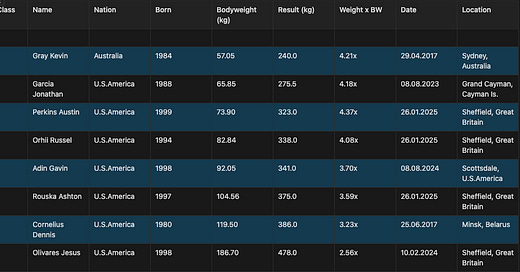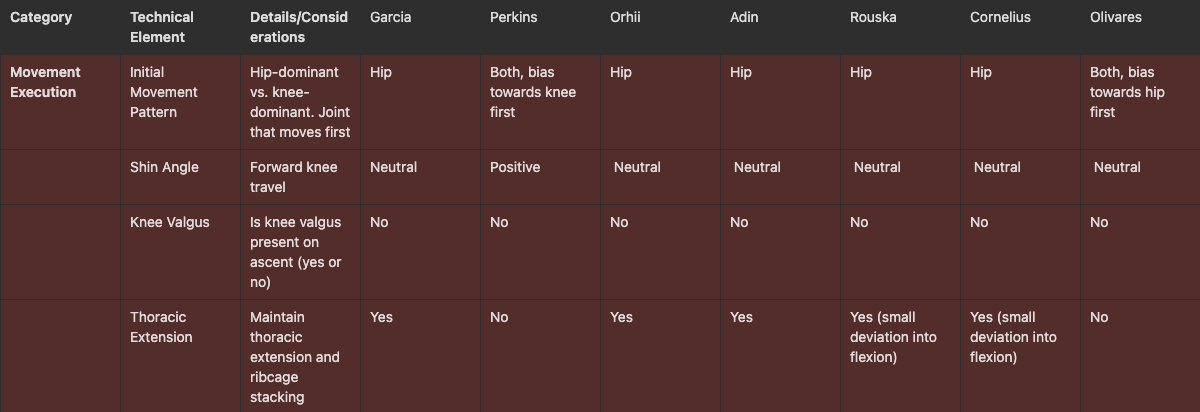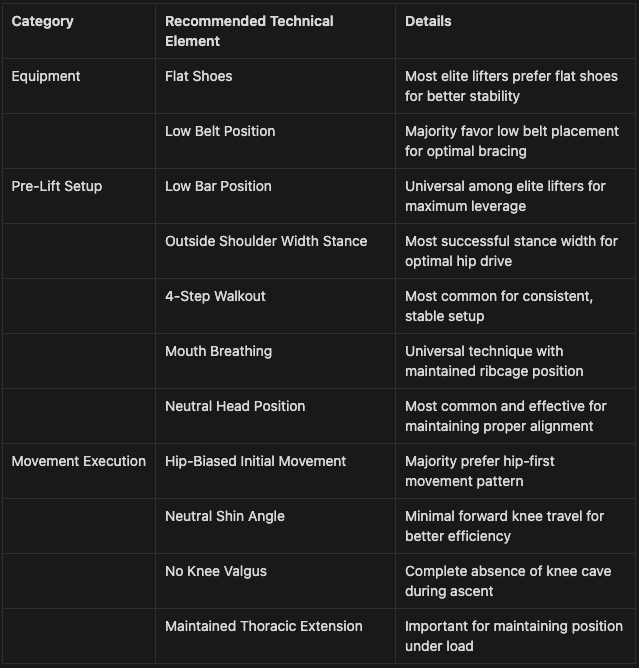Introduction
Over the next few weeks I will be diving into the technical elements of the 3 powerlifting disciplines for both men and women. The aim of this 6 part series of newsletters is to break down the common themes seen with the very best in the world to help lifters and coaches understand more about what to look for and whats important in developing a technically world class lift. Or just to allow lifters to realise their potential by focussing on the right things.
This is designed to be a technical guide, not a training guide (although I will follow up by breaking down the components over the course of the year)
For this week I will dive into the squat and look at the common themes seen across all the current successful mens world record attempts to help draw out the common themes seen.
This leads very nicely into a great quote…
What Are You Looking For?
”There are common positions and movement patterns you’ll see in high-level sprinters. But no two athletes express them exactly the same way. Strength levels, injury history, limb lengths, training background, it all plays a role. So I coach toward landmarks, not rigid shapes. I’m looking for consistency, not uniformity.”
The above is a quote from master track and field coach Dan Pfaff. The word genius gets used far to frequently but Dan is right up there as one of the best coaches of all time and a genius!
Dan has helped some of the greats in track and field achieve Olympic gold, world records and have long lasting careers despite long standing injury issues. What he is saying in the quote is related to sprinting ‘but’ you can apply the same logic to Powerlifting. There will be certain aspects across all of the current world records which will help with understanding ‘what’ is important and ‘why’ it is important.
Of course there will be nuance with every lifter due to individual variance but that comes when you understand either yourself (self coached) or your athlete (coached) to a very high level.
The Process
We are looking for common themes across the best in all weight classes to find those things that are key to achieving great squats.
I set about analysing each of the world records and created a table which highlights the key aspects of the squat. This would be very similar to the process I would use during the assessment process when lifters join 949strength, what are they doing and what impact would that have on force expression and injury prevention.
The process then was to compare each world record holder on these key components to find themes across all the attempts.
*I was unable to find footage of the 59kg world record attempt which was frustrating but the list is fairly comprehensive without so i hope it still gives the correct advice post.
Equipment
Footwear
5/7 lifters wore flats for the squat. A clear indication that flats should be recommended for most lifters. Although we would all know very good lifters who wear heels and get great outcomes. The use of flats complements the following styles more, low bar, hip biased, neutral shin angle lifters. So the recommendation of flats would be based on the following technical findings.
Belt Placement
5/7 lifters wore their belt higher on the midsection. Personal preference comes into this. The findings would suggest a lower belt placement for achieving your best squat.
Pre-Lift Set Up
Bar Position
Every lifter utilised a low bar position, there is some variance on exactly where the bar sits. Jesus Olivares being a great example of a low bar squat but due to his overall size it almost sits like a high bar on his back. Low bar is clearly a must for anybody looking to squat to their potential.
Hand Placement
The lighter weight classes trended towards hands being inside the rings rather than outside. Due to the large variance in limb lengths this is clearly determined by the size of the individual and should not be an enforced standard.
Elbow Angle
The majority of lifters opted for a downward biased elbow angle as opposed to the elbows point backwards bias. As I was told by world record squatter Wade Hooper at my first world championships, if my elbows point backwards I will push the bar forwards as I start the ascent. Not a great outcome, especially for an equipped squatter. An elbows down bias is a recommended set up position to work towards.
Walkout
I had written about my preferences on the walkout previously and the insights I had (3 step walkout) are actually different to the findings here. The majority of lifters 5/7 are opting for 4 steps to get set up optimally. The final step being a very small adjustment to find the perfect setup. Only Austin Perkins who is a narrower squatter, opted for 2 steps and Dennis Cornelius opting for 3 steps. The big takeaway for me is the precision of the walkout, be certain you have your feet where you need them.
Stance
The preferred stance appears to be outside of shoulder width, 5/7 lifters use this stance width, both Austin Perkins and Gavin Adin I would class as shoulder width, with the obvious drawback of this visual analysis being the actual width of the lifters shoulders. Jonathon Garcia would be classed as a very wide squatter and interestingly was the only lifter to take a true 4th step to setup his squat. Just outside of shoulder width appear to be most beneficial stance to adopt.
Breathing and Bracing
A strange topic but one I think is important, you see a whole host of different styles and techniques with bracing, and lifters potentially not paying enough attention to this area of the setup of the squat. Mouth inhalation vs nasal inhalation and changes to the position/stacking of the ribcage are important here. All lifters took a breath through the mouth (there is some really interesting insights into breathing mechanics but way too much for this article). Most 4/7 lifters did not change their ribcage height, up or down to improve stacking, two lifters opted for a lift and further extension of the ribcage, 1 opted for a drop in ribcage height. It would appear that just taking a good breath and maintaining position would be a favourable outcome for most squatters.
Head Position
4/7 lifters maintained a neutral head position (not looking up significantly or down significantly), 2 lifters had head looking up, 1 lifter looking down. The focus of the eyes is also important with most maintaining a neutral eyeline. There are no clear indications for certain head positions and eyelines based on these lifters. Lots of variance was seen but neutral head and eyeline appear to be important followed by looking up. Having head tilted down and eyeline down appears to be less favourable.
Movement Execution
Initial Movement
The majority of lifters (6/7) adopted a hip biased approach when starting the descent, meaning the hip moved first in the sequence followed by knee flexion. An important distinction as the hip extensors are found to contribute more in elite squatters than sub-elites showing this very subtle technical skill in action.
Shin Angle (Knees Over Toes)
The shin angle remained neutral (did not significantly track over the toes) in 6/7 of the lifters. The only lifter who did bias towards this was Austin Perkins, who was also biased towards a knee first movement pattern to initiate his squat. Hips first would appear to facilitate a neutral shin more effectively. This is important due to improved economy of effort, the further the shin travels forwards the further the hip must travel down to make depth in the competition squat.
Knee Valgus (Knee Cave)
No lifter showed any knee valgus during the ascent of the squats. This has been a contentious point as it is common in a lot of female lifters. The study that shows increases in glute activity as you have more knee valgus is of less relevance than observing the very best in the world (mens) and there being a distinct lack of valgus force when executing world records. This aspect should be cued as a start point if you do it and then have a well structured programme that addresses individual muscle weakness and gross motor control at the compromised ranges.
Thoracic Extension (Upper Back Rounding)
Only two lifters exhibited a significant loss of thoracic extension, Austin Perkins and Jesus Olivares, as mentioned earlier, Austin has the narrowest of the stances used and more knee flexion (greater quads emphasis) and Jesus has a low bar position which effectively sits like a high bar squat. Both instances increase the likelihood of upper back rounding as the emphasis moves toward the knee extensors (quads) rather than the hip extensors (glutes, hamstring) to complete the squat.
The Roundup
What would you want you squat to look like? What are the key aspects to focus on. I believe the table below helps narrow the options down
Pt 2 in the series will look at the women’s world record squats and the commonalities there. Subscribe below to get it directly in your inbox.









